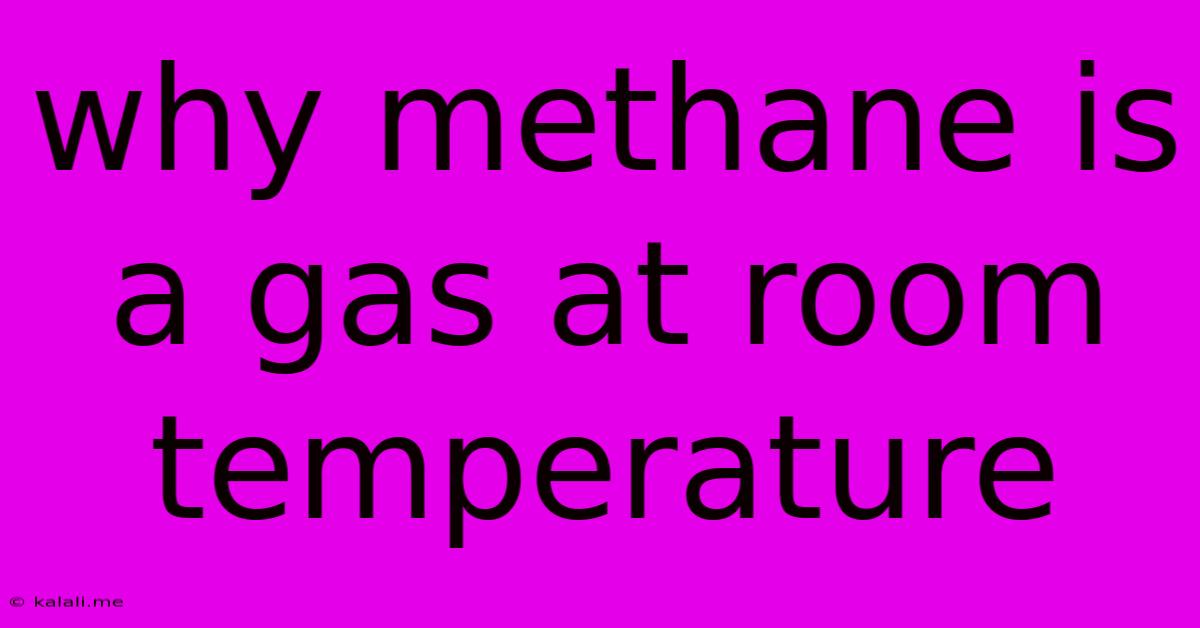Why Methane Is A Gas At Room Temperature
Kalali
May 21, 2025 · 3 min read

Table of Contents
Why Methane is a Gas at Room Temperature: Understanding Intermolecular Forces
Methane (CH₄), the simplest alkane, exists as a gas at room temperature. This seemingly simple fact is a consequence of the relatively weak intermolecular forces present between methane molecules. Understanding these forces is key to grasping why methane remains a gas even at relatively mild temperatures. This article will delve into the molecular structure of methane and explain the dominant intermolecular forces, or lack thereof, that determine its gaseous state.
Understanding Intermolecular Forces
Intermolecular forces are the forces of attraction or repulsion which act between neighboring particles (atoms, molecules, or ions). These forces are crucial in determining the physical properties of substances, including their state of matter at a given temperature. Stronger intermolecular forces lead to higher boiling points and melting points, often resulting in liquids or solids at room temperature. Weaker forces mean substances are more likely to exist as gases.
Several types of intermolecular forces exist, including:
- London Dispersion Forces (LDFs): Present in all molecules, these are weak forces caused by temporary, instantaneous dipoles that arise due to the random movement of electrons. The larger the molecule, the stronger the LDFs.
- Dipole-Dipole Forces: Occur in polar molecules, where there's an uneven distribution of electron density, creating a permanent dipole moment.
- Hydrogen Bonding: A special type of dipole-dipole interaction that occurs when a hydrogen atom is bonded to a highly electronegative atom (like oxygen, nitrogen, or fluorine). Hydrogen bonds are relatively strong intermolecular forces.
Methane's Molecular Structure and Weak Intermolecular Forces
Methane's tetrahedral structure, with a carbon atom at the center and four hydrogen atoms bonded to it, is crucial. The C-H bonds are relatively nonpolar because the electronegativity difference between carbon and hydrogen is small. This means methane is a nonpolar molecule.
Because methane is nonpolar, it lacks dipole-dipole forces. The only intermolecular forces present are London Dispersion Forces (LDFs). While LDFs are present in all molecules, they are relatively weak in methane due to its small size and low molecular weight. The small size limits the surface area available for interaction, and the low mass results in less electron movement and weaker instantaneous dipoles.
The Implications of Weak Intermolecular Forces
The weak LDFs in methane mean that the attractive forces between individual methane molecules are insufficient to hold them together in a liquid or solid state at room temperature. The thermal energy of the molecules at room temperature is greater than the energy of the intermolecular attractions. This allows the methane molecules to overcome the weak LDFs and exist as a gas. Only at significantly lower temperatures, where thermal energy is reduced, do the LDFs become significant enough to allow methane to condense into a liquid and then a solid.
In Conclusion
Methane's existence as a gas at room temperature is directly related to its nonpolar nature and the resulting weak London Dispersion Forces between its molecules. The small size and low molecular weight of methane further contribute to these weak intermolecular attractions. This makes it relatively easy for methane molecules to overcome these forces and exist in the gaseous phase under normal conditions.
Latest Posts
Latest Posts
-
One Tick On Whatsapp But Not Blocked
May 21, 2025
-
Can I Bring Toothpaste On My Carry On
May 21, 2025
-
How To Turn Off Motorola G13
May 21, 2025
-
Jesus Was Asleep In The Boat
May 21, 2025
-
How To Change Your Phone Number Iphone
May 21, 2025
Related Post
Thank you for visiting our website which covers about Why Methane Is A Gas At Room Temperature . We hope the information provided has been useful to you. Feel free to contact us if you have any questions or need further assistance. See you next time and don't miss to bookmark.